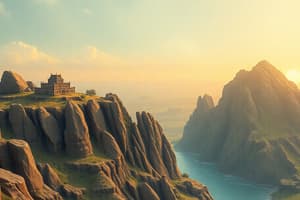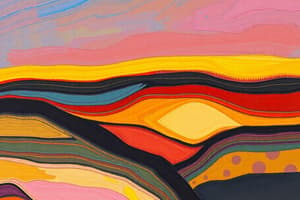Podcast
Questions and Answers
What is the first step in the Scientific Method?
What is the first step in the Scientific Method?
- Question (correct)
- Experiment
- Hypothesis
- Research
Which layer of the Earth is liquid?
Which layer of the Earth is liquid?
- Mantle
- Outer Core (correct)
- Inner Core
- Crust
What type of rock is formed under heat and pressure?
What type of rock is formed under heat and pressure?
- Volcanic
- Metamorphic (correct)
- Sedimentary
- Igneous
Which phase of the moon comes after the Waxing Gibbous?
Which phase of the moon comes after the Waxing Gibbous?
What is the basic unit of life?
What is the basic unit of life?
What is the process called where plants convert sunlight into energy?
What is the process called where plants convert sunlight into energy?
Which type of energy is associated with motion?
Which type of energy is associated with motion?
Which law states that for every action, there is an equal and opposite reaction?
Which law states that for every action, there is an equal and opposite reaction?
What is the main function of the circulatory system?
What is the main function of the circulatory system?
Which of the following is not a type of simple machine?
Which of the following is not a type of simple machine?
Flashcards are hidden until you start studying
Study Notes
Scientific Method
- Steps:
- Question: Ask a question about an observation.
- Research: Gather information and resources.
- Hypothesis: Propose a testable explanation.
- Experiment: Conduct tests to support or refute the hypothesis.
- Analysis: Examine data and draw conclusions.
- Conclusion: State findings and whether the hypothesis was supported.
Earth and Space Science
-
Layers of Earth:
- Crust: Outer layer, solid rock.
- Mantle: Thick layer, semi-solid rock, convection currents occur.
- Outer Core: Liquid iron and nickel.
- Inner Core: Solid iron and nickel, very hot.
-
Rock Cycle:
- Igneous: Formed from cooled magma.
- Sedimentary: Formed from sediment compression.
- Metamorphic: Formed from heat and pressure on existing rocks.
-
Phases of the Moon: New Moon, Waxing Crescent, First Quarter, Waxing Gibbous, Full Moon, Waning Gibbous, Last Quarter, Waning Crescent.
Life Science
-
Cell Basics:
- Basic unit of life.
- Plant cells have cell walls and chloroplasts; animal cells do not.
-
Photosynthesis:
- Process by which plants convert sunlight into energy.
- Formula: Carbon Dioxide + Water + Sunlight → Glucose + Oxygen.
-
Ecosystems:
- Comprised of living organisms (biotic factors) and non-living components (abiotic factors).
- Examples include forests, deserts, wetlands.
Physical Science
-
Matter: Anything that has mass and takes up space; exists in three states: solid, liquid, gas.
-
Simple Machines:
- Lever: Increases force or distance.
- Inclined Plane: Reduces effort needed to raise an object.
- Wheel and Axle: Reduces friction and helps movement.
-
Forces and Motion:
- Force: A push or pull on an object.
- Newton’s Laws of Motion:
- An object at rest stays at rest unless acted upon by a force.
- Force = Mass x Acceleration.
- For every action, there is an equal and opposite reaction.
Human Body Systems
- Major Systems:
- Circulatory: Transports blood and nutrients.
- Respiratory: Exchanges oxygen and carbon dioxide.
- Digestive: Breaks down food and absorbs nutrients.
- Skeletal: Provides structure, protection, and support.
- Muscular: Enables movement through contractions.
Energy
-
Types of Energy:
- Kinetic: Energy of motion.
- Potential: Stored energy.
- Thermal: Heat energy.
- Solar: Energy from the sun.
-
Energy Transfer: Energy can change from one form to another (e.g., potential to kinetic when an object falls).
Scientific Method
- The scientific method is a systematic approach to understanding the natural world.
- It involves a series of steps that help to ensure that findings are reliable and objective.
- The scientific method includes: asking a question, researching, forming a hypothesis, conducting an experiment, analyzing data, and drawing a conclusion.
Earth and Space Science
- The Earth is made up of several layers: the crust, mantle, outer core, and inner core.
- The crust is the outermost layer, composed of solid rock.
- The mantle is a thick layer of semi-solid rock, where convection currents occur.
- The outer core is composed of liquid iron and nickel.
- The inner core is composed of solid iron and nickel and is extremely hot.
- The rock cycle describes the continuous process of rock formation, transformation, and destruction.
- The three main types of rocks are igneous, sedimentary, and metamorphic.
- Igneous rocks are formed from cooled magma.
- Sedimentary rocks are formed from sediment compression.
- Metamorphic rocks are formed from heat and pressure applied to existing rocks.
- The Moon goes through different phases as it orbits the Earth: new moon, waxing crescent, first quarter, waxing gibbous, full moon, waning gibbous, last quarter, and waning crescent.
Life Science
- The cell is the basic unit of life.
- Plant cells have cell walls and chloroplasts, which animal cells do not have.
- Photosynthesis is the process by which plants convert sunlight into energy.
- The formula for photosynthesis is: Carbon Dioxide + Water + Sunlight → Glucose + Oxygen
- Ecosystems encompass all living organisms (biotic factors) and non-living components (abiotic factors).
- Examples of ecosystems include forests, deserts, and wetlands.
Physical Science
- Matter is anything that has mass and takes up space.
- Matter exists in three states: solid, liquid, and gas.
- Simple machines are tools that make work easier.
- Examples of simple machines include levers, inclined planes, and wheels and axles.
- Levers increase force or distance.
- Inclined planes reduce the effort needed to raise objects.
- Wheels and axles reduce friction and help with movement.
- A force is a push or pull on an object.
- Newton's Laws of Motion describe how objects move under the influence of forces.
- Newton's First Law of Motion: an object at rest stays at rest unless acted upon by a force.
- Newton's Second Law of Motion: Force = Mass x Acceleration.
- Newton's Third Law of Motion: For every action, there is an equal and opposite reaction.
Human Body Systems
- The human body is made up of many different systems that work together to keep the body functioning.
- The circulatory system transports blood and nutrients throughout the body.
- The respiratory system exchanges oxygen and carbon dioxide.
- The digestive system breaks down food and absorbs nutrients.
- The skeletal system provides structure, protection, and support for the body.
- The muscular system enables movement through muscle contractions.
Energy
- Energy is the ability to do work.
- Kinetic energy is the energy of motion.
- Potential energy is stored energy.
- Thermal energy is heat energy.
- Solar energy is energy from the sun.
- Energy can be transferred from one form to another. For example, potential energy is converted to kinetic energy when an object falls.
Studying That Suits You
Use AI to generate personalized quizzes and flashcards to suit your learning preferences.




